Latest News
August 1, 2010
By Blake Courter
Ask any avid golfer, and he or she will tell you that the most important aspect of the game is the golf ball. It is, in fact, in play on every shot. And golf, by rule—unlike any other sport—allows each player to play a different ball.
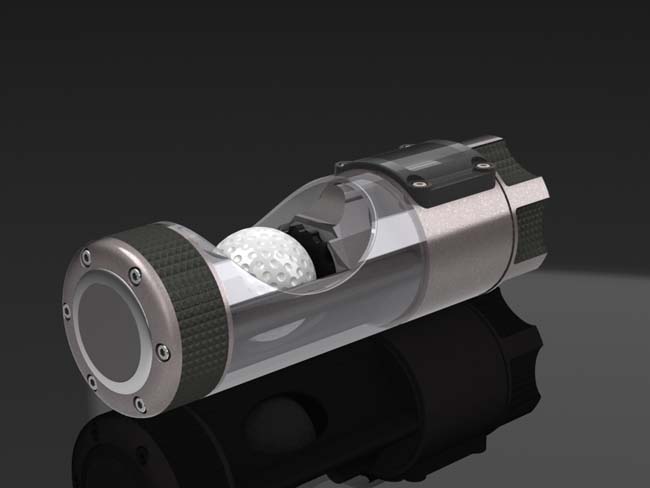 The second ballometer prototype took a cylindrical approach to the tool. |
To meet this proposition, there are hundreds of golf balls from which to choose. However, a ball manufacturer recently determined that half of all golfers play the wrong one—a ball that is not best fit for their club head speed.
At a higher defined swing speed, a harder-core ball travels further than a softer one. At a slower speed swing, a lower-compression ball will achieve greater distance. This direct correlation among swing speed, ball compression and distance can also be mapped out for a ball’s other major characteristic, its “feel.” Thus, determining the right ball for each player starts with understanding compression.
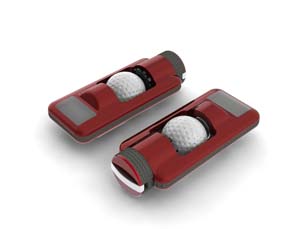 With the third prototype, Dan Falvey used the iPhone as his shape inspiration, to make the design more compact and pocket/golf bag friendly. |
Mass-produced golf balls do not report exact compression. However, golf ball manufacturers do market their products with a descriptive “feel.” That may be in part because of a lack of industry measurement uniformity—sometimes even among the same family of balls. A simple deflection-compression measurement tool only reports “the ball you have in your hand,” results that can vary widely. To date, there has not been a handheld device that accurately reports the exact characteristic of any given golf ball.
With hundreds of different ball types on the market today, one can see the challenges golfers face in finding the right ball. A best-fit ball could enhance the experience and enjoyment of playing golf by giving golfers the opportunity to lower their scores.
BallLogic LLC, a privately held company headquartered in Portland, OR, identified this market opportunity and developed the idea for a handheld golf ball tool. The company’s goal was to accurately and easily measure compression against a uniform scale. Rather than being deflection-based, this new product—coined a “ballometer” by its founder—would be based on a force protocol.
The tool’s key differentiator is that it eliminates variances of compression-testing a ball. Additionally, knowing that golf balls are sensitive to temperature changes, the BallLogic team wanted a product that would include a built-in thermostat—which can also factor into choosing a best-fit ball.
BallLogic’s team turned to external experts for the electronics, design and packaging. Dan Falvey, CEO of Tools4Design and a product designer with 30 years of experience, was selected to design the ballometer’s form factor. Falvey was also charged with optimizing the product for cost-effective manufacturability.
Falvey’s experience spans many consumer projects for some of the world’s best-known brands, including sporting goods manufacturers Nordica and Easton, as well as plastic toys for McDonald’s Happy Meals. Also of note, Falvey was the first product development engineer hired at Williams-Sonoma.
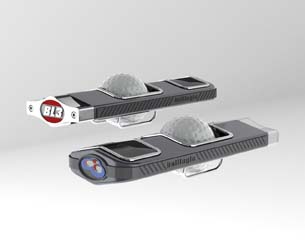 Reservations about the round knob protrusion in design 3 led Falvey to include in the final design a new shape for the knob, enhancing leverage and ergonomics while maintaining the same pocket and golf bag friendliness. |
As a sole practitioner, Falvey typically works on four to seven projects at the same time. On any given day, his work consists of enhancing golf club models or reworking the geometry of a carbon-fiber bike frame. He uses a range of tools in his work, including four different computer-aided design (CAD) systems. SpaceClaim Engineer, a 3D direct modeling solution designed to enable concept modeling, model preparation and accurate bid preparation, is also part of Falvey’s toolbox.
Getting Started
When Falvey started working with BallLogic, the functional core assembly for the ballometer had already been designed. Falvey began work on the exterior form factor, and was provided with specific criteria on packaging design, including the stipulation that it had to fit into the size of a sleeve of golf balls. It also needed to be easy to deploy and repeatable in use.
The cost to manufacture was also a key part of the equation. As the ballometer represented a new brand category in golf and there was no existing body of knowledge, Falvey’s real challenge was to start his concept modeling from scratch.
At a minimum, the enclosure design had to encompass a light-emitting diode (LED) display, a knob to apply force and generate the compression reading, a thermostat and a convenient slot for the ball to rest (while being measured). Falvey used SpaceClaim Engineer for this project. It enabled him to create many iterations and cross-sections of each design concept.
Falvey’s initial concepts took about seven hours to create. Dealing with the tightly packed nature of the components, he set up ten to fifteen different cross-sections where he could create and edit the design. One of the most challenging aspects was designing the knob used to exert force on the golf ball and measure compression. With SpaceClaim, Falvey was able to easily move and push elements to converge on the prototype he presented to the BallLogic team.
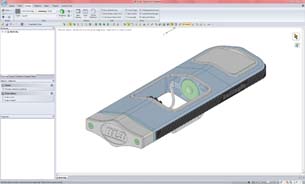 Final ballometer design modeled in SpaceClaim Engineer. |
Rather than repeatedly travel to Oregon to present his designs, Falvey was able to show the BallLogic team the concepts in real time, leveraging SpaceClaim and GoToMeeting. This collaborative virtual environment allowed him to make edits while they reviewed and discussed the designs. By editing designs on the fly with his clients, Falvey could test out new ideas online, and optimize his and the client’s time with effective results.
“Make It Look Cool”
The third ballometer concept Falvey developed, cylindrical and intended to meet the golf sleeve size requirement, was taken to the 2010 PGA Merchandise Show in prototype form for further testing. Falvey also used SpaceClaim to create mock-ups of different possible versions of the product, and applied photorealistic renderings to enhance the presentation.
Focus group testing at the PGA Show provided immediate and unanimous feedback. The product represented a giant leap forward for golfers, but needed to be designed in a smaller package. To enhance marketability of the final design, Falvey noted key comments to “make it look cool, like the latest smart phones.”
A product that would slide into a golfer’s pocket and look sleek and modern would surely drive consumer appeal. To do this, the ballometer knob had to be flattened, yet easy to turn. SpaceClaim helped Falvey optimize this new design for manufacturability, designing a housing that could be made from a precision thin extrusion, rather than die cast. An added benefit would be saving thousands of dollars on machine tooling, plus making the ballometer easy to assemble.
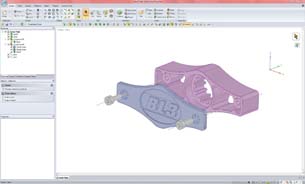 Falvey used SpaceClaim Engineering’s surfacing and solid modeling capabilities to define the final design of the lever. |
Falvey went back to work in SpaceClaim, saving different versions and modeling the ballometer in multiple forms until he had created the optimal design. The final and patented design, the BL3 ballometer, was unanimously accepted by BallLogic. The team then went on the road to introduce the product to key influencers in the golf and sporting goods arena.
The BallLogic BL3 ballometer will begin final production later this year, and be introduced at the PGA Merchandise Show in early 2011.
“Dan was spot-on, and we are very pleased with the results,” says BallLogic Founder Tod Ingram. “The golf space is buzzing with news of this new product, and we are looking forward to introducing this next big thing in the industry.”
More Info:
BallLogic LLC
GoToMeeting
SpaceClaim Corp.
For more information about this topic, visit deskeng.com.
Blake Courter is a co-founder of SpaceClaim Corp. He started his career at PTC, where he held a range of product management and business development positions. He received a bachelor’s degree in mechanical engineering from Princeton University in 1996.
Subscribe to our FREE magazine, FREE email newsletters or both!
Latest News
About the Author
DE’s editors contribute news and new product announcements to Digital Engineering.
Press releases may be sent to them via [email protected].






